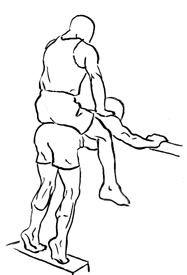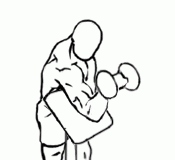Last Updated on September 30, 2022
If you’re looking to build serious calf muscles and take your lower body training to the next level, the Donkey Calf Raises is one exercise you shouldn’t skip. This old-school, advanced gym movement is highly effective at isolating and targeting your calves, particularly the gastrocnemius muscle. However, it requires a good deal of strength, balance, and sometimes the help of a partner, so it’s not a workout for beginners. In this article, we’ll break down everything you need to know about donkey calf raises: how to perform them correctly, why they’re so effective, and how to safely incorporate them into your routine.
What Are Donkey Calf Raises?
Donkey calf raises are an advanced calf-strengthening exercise that involves bending at the waist and raising your heels off the floor while supporting weight on your back. While traditional calf raises are done standing with weights in hand or a barbell on your shoulders, donkey calf raises allow you to work from a bent-over position, often with a partner or machine adding resistance to your lower back. This change in posture puts a unique stretch on your calves, making it a highly effective exercise for building size and strength in this muscle group.
This exercise was made famous by bodybuilders like Arnold Schwarzenegger in the golden age of bodybuilding, but it’s still widely used today because of its effectiveness in sculpting and growing the calf muscles. However, it’s essential to know that this exercise requires proper form and execution to avoid injury.
Benefits of Donkey Calf Raises
Here are a few reasons why donkey calf raises are so popular among advanced athletes and bodybuilders:
- Greater Stretch for Calves: The forward lean involved in donkey calf raises provides a deeper stretch in the gastrocnemius (the larger, visible calf muscle), promoting better muscle activation and growth.
- Added Resistance: By having a partner or using a machine, you can easily overload the calf muscles with more weight, encouraging muscle growth. This is harder to achieve with traditional standing calf raises.
- Variety in Your Training: Most people only perform standing or seated calf raises. Adding donkey calf raises provides variety and challenges your calves in a different way, which can lead to greater muscle development over time.
- Engages Core and Lower Back: The bent-over position forces your core and lower back to engage to stabilize your body, providing an additional workout for these muscle groups.
Step-by-Step Guide to Performing Donkey Calf Raises
Before attempting donkey calf raises, it’s important to warm up properly to prevent injury. A dynamic warm-up involving ankle rolls, calf stretches, and light cardio (like walking or jumping rope) will ensure your calves are ready for the intense work to come.
Here’s how to perform the donkey calf raise correctly:
1. Set Up
- Find a Bench or Stable Surface: First, find a waist-height bench, rack, or another stable surface to lean on. This will support your upper body while performing the exercise.
- Partner or Machine: Donkey calf raises can be done with a partner sitting on your lower back, or using a donkey calf raise machine if your gym has one. If you’re using a partner, make sure they are light enough for you to safely perform the movement with proper form.
2. Body Position
- Bend Forward at the Waist: Once you’re ready, bend forward at the waist so that your upper body is parallel to the ground. Your arms should rest on the bench or weight rack for support.
- Feet Positioning: Place your feet hip-width apart, and make sure your toes are pointed forward. Your heels should be slightly elevated off the floor to begin with.
3. Engage Your Core
- Stabilize Your Body: Engage your core and lower back muscles to maintain a stable, neutral spine while performing the movement. This is crucial for preventing injury, especially when a partner or machine is adding weight to your back.
4. Begin the Calf Raise
- Lift Your Heels: Slowly raise your heels off the floor, pushing through the balls of your feet. Keep your knees slightly bent but not locked. As you lift, focus on contracting your calf muscles.
- Lean Slightly Forward: While raising your heels, lean slightly forward to shift the load onto your calves and maximize muscle engagement.
5. Pause at the Top
- Hold for a Moment: Once you’ve reached the top of the movement, pause and hold the position for 1-2 seconds. This will increase the time your calves are under tension, helping to stimulate more muscle growth.
6. Lower Your Heels
- Control the Descent: Slowly lower your heels back to the floor, maintaining control throughout the movement. Don’t just let your heels drop—control is key for preventing injury and maximizing muscle activation.
7. Repeat for Desired Repetitions
- Aim for High Reps: Since the calf muscles are generally endurance-based, aim for higher repetitions (12-20 reps per set). Start with 3-4 sets, and gradually increase the weight or number of sets as you become more comfortable with the exercise.
Common Mistakes to Avoid
When performing donkey calf raises, it’s important to avoid these common mistakes that can hinder your progress or lead to injury:
- Using Too Much Weight: Don’t overload the exercise with too much weight, especially when using a partner. Start with a manageable amount of resistance and gradually increase it over time. If you can’t complete your reps with proper form, you’re likely using too much weight.
- Not Controlling the Movement: Avoid rushing through the reps or letting your heels drop too quickly. Controlling the eccentric (lowering) portion of the movement is just as important as the lifting phase for building muscle.
- Locking the Knees: Keep a slight bend in your knees throughout the movement. Locking your knees can shift the tension away from your calves and put unnecessary strain on your joints.
- Poor Body Alignment: Maintain a neutral spine and engaged core to avoid placing unnecessary stress on your lower back. Proper form is key to preventing injury, especially when working with additional weight.
- Inconsistent Range of Motion: Ensure you’re lifting your heels as high as possible and lowering them completely to the ground during each rep. Partial reps won’t give you the full benefit of the exercise.
Variations and Alternatives
If you’re not quite ready to tackle donkey calf raises or you want to add variety to your calf routine, here are some alternatives and variations that can help build strong, well-rounded calves:
1. Standing Calf Raises
Standing calf raises are a great alternative for beginners or anyone without a workout partner. These can be done with body weight or by holding dumbbells, and they target the same muscle groups as donkey calf raises.
2. Seated Calf Raises
Seated calf raises primarily target the soleus, the smaller calf muscle that lies underneath the gastrocnemius. Incorporating seated calf raises can help ensure balanced development of both calf muscles.
3. Single-Leg Donkey Calf Raises
For an added challenge, try performing donkey calf raises one leg at a time. This increases the difficulty and forces each calf to work independently, promoting balanced muscle development.
4. Smith Machine Donkey Calf Raises
If you don’t have a partner or a donkey calf raise machine, you can replicate the movement using a Smith machine. Set the bar at waist height, lean forward under the bar, and perform the calf raises with the bar providing added resistance.
Safety Tips
Since donkey calf raises involve a bent-over position and added weight on your lower back, safety is paramount. Follow these tips to ensure a safe and effective workout:
- Use a Spotter or Personal Trainer: If you’re new to donkey calf raises or working with a partner, have a spotter or personal trainer guide you through the movement. This will ensure you’re using proper form and help prevent injury.
- Warm-Up Thoroughly: Make sure to warm up your calves and lower body before attempting donkey calf raises. This will reduce the risk of strains or muscle injuries.
- Avoid Using Excessive Weight: Start with lighter weight or no weight at all, gradually building up as your strength increases. Avoid overloading the movement with too much weight, especially when working with a partner.
- Listen to Your Body: If you feel any discomfort or pain in your lower back or legs, stop immediately. Donkey calf raises can be intense, and it’s essential to prioritize form over weight or reps.
Are Donkey Calf Raises Right for You?
If you’re serious about developing strong, well-defined calves, donkey calf raises are a must-try exercise. With the right form and weight, this advanced movement can take your calf training to the next level. However, remember that it’s essential to have the necessary strength and experience before attempting this exercise, as it requires a combination of balance, stability, and muscle control. For those ready to take on the challenge, donkey calf raises will not only improve your calf size but also your overall lower body strength.
Incorporate this powerful exercise into your routine, and watch as your calves grow stronger and more defined over time.








